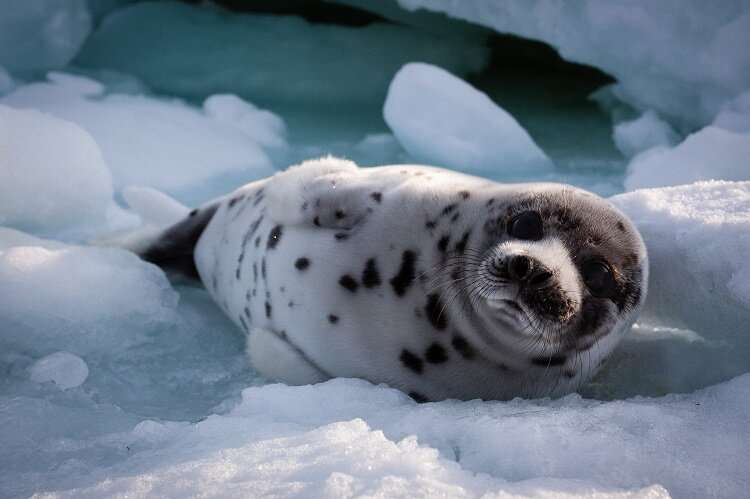Arctic seal pups learn to live on the edge

Young harp seals diving for the first time can adapt their behavior depending on local environmental conditions, according to new research at the University of St Andrews.
Using miniaturized computers developed and built by the Sea Mammal Research Unit Instrumentation group at the University of St Andrews, scientists tracked the first migrations made by harp seal pups from breeding areas in north-eastern Canada and the Greenland Sea.
The pups traveled up to 3500km north into Baffin Bay, the northern Barents Sea and the Arctic Ocean using migration routes similar to those previously recorded for adult harp seals.
The devices used by the scientists also recorded how the dive behavior of the seal pups developed as they began to forage.
This research, published in Royal Society Open Science, revealed an interesting difference. Diving behavior was similar for both populations over the first 25 days, likely due to the seals developing the ability to hold their breath and dive to depth for extended periods.
However, animals tagged in the Greenland Sea went on to perform shorter and shallower dives and were more closely associated with sea ice than animals tagged in the Gulf of St Lawrence.
Lead author Dr. James Grecian of the Sea Mammal Research Unit at the University of St Andrews says that "the young harp seals we tracked in the Greenland Sea had access to sea ice for several months after they were born, and so learnt to dive around the ice edge."
"In contrast, the ice in the Gulf of Lawrence retreated much earlier and, rather than chase after it, the seals born there learnt to dive in a more ice-free environment."
"These differences in how much the two populations associated with the ice edge and their diving depths suggest a degree of flexibility in early life foraging behavior."
However, despite the ability to dive in a more ice-free environment, the seals still rely on the sea ice as a safe place to give birth and raise their young.
The Arctic is changing at an unprecedented rate, and experts from the University of St Andrews have been working to understand the impacts of these changes on the animals that inhabit this fragile ecosystem.
Harp seals rely on Arctic sea ice. They breed on the ice and forage around the ice edge, migrating thousands of kilometers to follow the ice as it retreats north over the summer. This makes them vulnerable to sea ice loss due to climate change.
They need thick ice floes that can withstand late winter storms, high winds, and waves. Global warming is impacting the formation of sea ice and reducing the stability of the ice as somewhere safe to breed.
Dr. Grecian added that "harp seal pups are weaned when they are just ten to 12 days old."
"After this time, the pups are left by their mothers and must fend for themselves. This means they need to learn quickly how to forage and make their first migrations as the ice breaks up on their own."
"Understanding how these behaviors develop provides an insight into how these animals may adapt to an ice-free Arctic."
More information: W. James Grecian et al, Environmental drivers of population-level variation in the migratory and diving ontogeny of an Arctic top predator, Royal Society Open Science (2022). DOI: 10.1098/rsos.211042
Journal information: Royal Society Open Science
Provided by University of St Andrews




















